Are you looking for a way to take a fundraising campaign to the next level? Show how your work impacts real people’s lives? Honor a special award winner? You’re probably familiar with the benefits of storytelling. However, good storytelling depends on obtaining excellent material in a form you can use.
Storytelling interview questions are a key focus for our team at MiniMatters. We develop our initial interview questions based on the circumstances and goals of each client, and based on the person we’re interviewing. Although we’re ready with follow up questions to keep things on track, we do find it extremely helpful to have a framework of storytelling interview questions when planning for an interview.
Below we share our Top 7 Interview Questions for Storytelling that can be used for stories destined for video or print. For video, we have an extra question for you as well.
Storytelling Interview Questions – Top 7
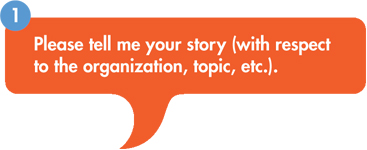
This type of open-ended question guided towards your organization or topic gets people talking and suggests good areas for follow-up. Listen carefully to the answers. Ask for more details, restatements, or clarification so you have several answers to choose from. Jot down and return to unexpected avenues that may arise from this question.
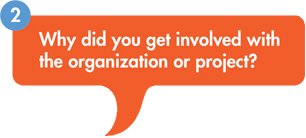
A “why” question reveals people’s motivation and demonstrates how they turned thought into action. When your interviewee shares the story of why they got involved with your organization or project, it prompts viewers to consider their motivations and for converting their thoughts into action. Perhaps the interviewee was in trouble and your organization helped them get back on track and now they are giving back. Or maybe your legacy giver was inspired by the compassionate support of your medical association towards her family members. Obtaining these sorts of “why” quotes or clips provides material for a story that can intensify the motivations of your viewers or readers.
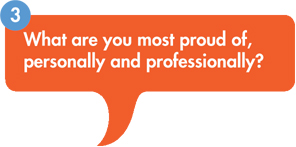
Asking a question about what makes someone feel proud provides the person with the opportunity to share how they want to be seen or remembered by others. This is especially valuable if your organization has helped them to succeed through a program your organization implements, or if their pride is tied to the mission of your organization. Everyone wants to feel good, and seeing interviewees feeling good will encourage your viewers or readers to seek opportunities that make them feel similarly.
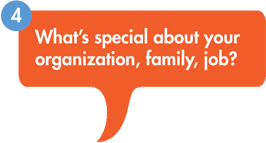
Stories are more interesting when they are about something unusual, unexpected, or not experienced already by your audience. Follow your interviewee’s lead in their answer by asking follow-up questions for more details–especially visual, auditory or other descriptions that can help audiences connect even more with that special aspect.
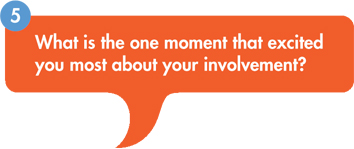
Asking for a single moment among many possibilities can help draw out an intense, emotional response rather than merely a list of things that are great, which delivers less punch and can seem rambling. So, ask for “one thing,” or “the best,” or the “most fantastic” when you can. If interviewing for video, judge the clip by whether you have obtained a vivid picture of the moment conveyed with engaged facial expressions. Laughter, tears, or other spontaneous emotions can really draw viewers in and hold their attention. And while people can get that “deer in the headlights” look on camera, a question like this can help bring an important smile.
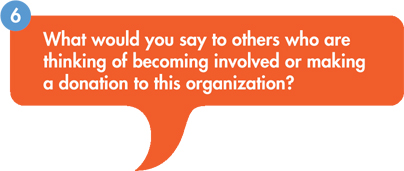
This question helps to obtain quotes or clips that reach out of the “flat” medium of the story to address the audience directly. On their own, answers to this question can make wonderful testimonials and can form a call to action at the close of the video, such as volunteering, donating, or registering for an event.
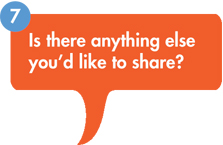
You can’t come up with all of the best questions. So, this last question is essential to make sure that you haven’t missed your best material. The question opens the door for the interviewee to say what they most want to share if they haven’t already done so. We find that sometimes we do get a fabulous quote that is what the interviewee has had on their mind most all along–or something fantastic that the process of the interview has generated. At other times, the interviewee is fully satisfied and relieved to be finished.
Whichever the case, when you’re finished, be sure to thank your interviewee for their time and for sharing their story!
BONUS TIP: Special for storytelling interview question for video
While these questions will work well for stories in print or video, in the case of video we suggest an additional question, which can occur well before or following the interview:
Do you have any photos or video footage that you could share that you think would add to your story?
This question may prompt your interviewee to describe something that you’ll be able to show in the video. If your interviewee does have such materials, make sure to indicate that digital photos need to be high resolution, preferably the original images (not just taken off of Facebook). Also indicate how they can send the photos or footage to you. Usually files of up to 10MB can be emailed, and multiple emails may be possible to send a larger number of photos. Photos or footage can also be put on a flash drive and mailed. And there are also large file transfer services like WeTransfer.com, or options like DropBox or Google Drive for sharing as well. Once you or an outside editor has this additional material, it can be combined with the interview sequences to create a more compelling story.
Get started on your story.
For ideas, you can view some of our interview videos in our portfolio.
To receive a PDF of our Top 7 Interview Questions for Storytelling, simply sign up on our email list. You’ll also receive other occasional video tips and articles and you can unsubscribe at any time. And let us know your smart video interview questions, too!

